Conferences
Dr. Dietrich Haubenberger of NINDS/NIH Gives Presentation On ET Outlook
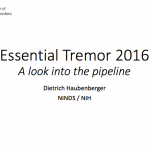 When we founded HopeNET 5 years ago, we felt that the thing that the ET community needed most at that time was HOPE – hence the name. In the meantime, we have strived hard to bring some hope to all with ET. Accordingly, HopeNET played a key role in having the ET conference at NIH in May 2015. Since that conference, there has been a big increase on the part of industry in developing new treatments for ET. Dr. Dietrich Haubenberger of NIH is probably in the best position to know what is going on with ET. He came to the Falls Church, Virginia ET support group on October 14th and made the attached presentation, Essential Tremor 2016: A look into the pipeline. There has never been a better time than right now for hope – for all of us in the ET community.
When we founded HopeNET 5 years ago, we felt that the thing that the ET community needed most at that time was HOPE – hence the name. In the meantime, we have strived hard to bring some hope to all with ET. Accordingly, HopeNET played a key role in having the ET conference at NIH in May 2015. Since that conference, there has been a big increase on the part of industry in developing new treatments for ET. Dr. Dietrich Haubenberger of NIH is probably in the best position to know what is going on with ET. He came to the Falls Church, Virginia ET support group on October 14th and made the attached presentation, Essential Tremor 2016: A look into the pipeline. There has never been a better time than right now for hope – for all of us in the ET community.
— Peter
Dr. Dietrich Haubenberger of NINDS/NIH Gives Presentation On ET Outlook
 When we founded HopeNET 5 years ago, we felt that the thing that the ET community needed most at that time was HOPE – hence the name. In the meantime, we have strived hard to bring some hope to all with ET. Accordingly, HopeNET played a key role in having the ET conference at NIH in May 2015. Since that conference, there has been a big increase on the part of industry in developing new treatments for ET. Dr. Dietrich Haubenberger of NIH is probably in the best position to know what is going on with ET. He came to the Falls Church, Virginia ET support group on October 14th and made the attached presentation, Essential Tremor 2016: A look into the pipeline. There has never been a better time than right now for hope – for all of us in the ET community.
When we founded HopeNET 5 years ago, we felt that the thing that the ET community needed most at that time was HOPE – hence the name. In the meantime, we have strived hard to bring some hope to all with ET. Accordingly, HopeNET played a key role in having the ET conference at NIH in May 2015. Since that conference, there has been a big increase on the part of industry in developing new treatments for ET. Dr. Dietrich Haubenberger of NIH is probably in the best position to know what is going on with ET. He came to the Falls Church, Virginia ET support group on October 14th and made the attached presentation, Essential Tremor 2016: A look into the pipeline. There has never been a better time than right now for hope – for all of us in the ET community.
— Peter
Register Now for the Essential Tremor Symposium on September 19, 2015
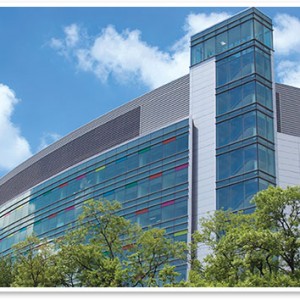 Essential Tremor (ET) affects 7 million Americans. If you, a family member, or a friend have ET, you are invited to attend a free symposium sponsored by HopeNET, an all-volunteer, non-profit.
Essential Tremor (ET) affects 7 million Americans. If you, a family member, or a friend have ET, you are invited to attend a free symposium sponsored by HopeNET, an all-volunteer, non-profit.
This symposium, with the ET support groups in Pennsylvania, Virginia & Maryland, will be held on September 19 from 10am until 12:30pm at Holy Cross Hospital, 1500 Forest Glen Rd., Silver Spring, Md. 20910. The theme of the symposium is Essential Tremor research and how those with it can participate in the trials. The three guest speakers will make a presentation on their respective research as well as answer any questions. There will also be an update on the results of the “Essential Knowledge gaps in the field of ET” Conference that was held at NIH on May 11-12 – as well as what has transpired since.
Information about HopeNET may be found at www.theHopeNET.org. You will need to register by either calling Peter Muller at 703-543-8131 or one of the contact people in each group – Walter Ebmeyer, Doris Mapes, Lisa Gannon, Mary Thomas, Barbara McCarthy or Prudy Bradley. As HopeNET is now doing more, please make a donation by going to our webpage or by mailing a check to 14425 Coachway, Centreville, Va. 20120.
September 19, 2015 Symposium Speaker – Kelly Naranjo
 Kelly Naranjo is going to be a speaker at the September 19, 2015 Symposium discussing a new study as mentioned below in her letter to HopeNet. Please contact her at tremor@yale.edu if interested.
Kelly Naranjo is going to be a speaker at the September 19, 2015 Symposium discussing a new study as mentioned below in her letter to HopeNet. Please contact her at tremor@yale.edu if interested.
Dear Peter,
My name is Kelly Naranjo and I am one of the new research associates at Yale University working under Dr. Elan Louis in a new study looking at the genetics of essential tremor in families. I have been reading a bit about your efforts to increase awareness of essential tremor and it is truly remarkable, your open letter in HopeNet is especially moving. I think that for the majority of the population, it is very difficult to understand the underlying effects of any medical condition unless they themselves or a loved one suffers from it. That is why education and information is always so important and I truly applaud all your efforts.
I am reaching out to you today because I wanted to tell you a bit more about our new study. I think you might smile a bit because due in part to advocates like yourself, we have more people interested in funding research and working towards finding more information about essential tremor, its causes and in the future a cure. In the previous study FASET I- family study on essential tremor- the research team also looked at genetic factors and a lot of knowledge was gathered, such as the correlation of ages of onset of tremor in various family members. Unfortunately, because the NIH only funded the project for three years and the budget was limited it was not possible to look at unaffected family members.
I wanted to let you know that FASET II, is currently the largest ever NIH funded grant ever, working with participants suffering from essential tremor. The funding period for FASET II is five years and our budget is a lot more generous. This time around we will be collecting samples for DNA analysis for affected as well as unaffected family members. There have been some proposed affected gene loci and having DNA information for the unaffected family members will confirm if any of the proposed gene clusters is a genetic factor.
I wanted to also add that recruiting participants and their families will be a huge effort and we are asking for your help! As an ET advocate and public speaker, I was wondering if perhaps you could help us connect with your network and people who might be interested in participating in this study? I would love to speak on the phone and tell you a bit more about what exactly we are we doing and if you are interested I can even put together a publication package about the interesting findings from the previous study. Please let me know when would be a good time talk on the phone, or if email is easiest.
My contact information is:
Kelly V. Naranjo, B.A Postgraduate Research Associate
Yale School of Medicine Department of Neurology
Thank you! And I look forward to hearing from you soon.
Best, Kelly
Essential Tremor Symposium at Holy Cross Hospital
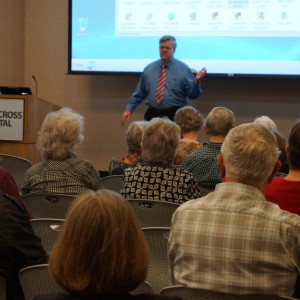
The June 6th Essential Tremor support group meeting at Holy Cross Hospital in Silver Spring, MD brought together close to 50 members of area Essential Tremor support groups from places like Silver Spring and Columbia, Maryland and Loudoun County and Falls Church, Virginia. There were two speakers preceded by remarks by Peter Muller from HopeNet. Muller informed the audience about what happened last month at a conference HopeNet worked to arrange, held at the National Institute of Neurological Disorders and Stroke (NINDS), a part of NIH. Forty neurologists and ET researchers attended the conference. What they agreed on is that treatment for ET is not possible if they do not know what the condition is. ET presents differently in each person, with varying symptoms such as hand tremors, head tremors, voice tremors, etc., and there can be overlap with other conditions such as Dystonia. These experts decided it would be beneficial to use hand tremors as the focal point to pinpoint what ET is, which suggests there will be upcoming studies.
Moving on, the support group audience was fortunate to hear from Dr. Maguire-Zeiss of Georgetown University’s Department of Neurology who gave a brief overview of the mechanisms in the brain thought to be involved in ET such as the cerebellum, motor cortex and thalamus. There is a question about the role the inferior olive plays as well. Maguire-Zeiss focused on neurons and likened the movement of neurons in the brain to an (electric) circuit and pointed out that if there is a “hiccup in the loop,” that can lead to more body movement (as seen in ET) or less body movement (as seen in Parkinson’s Disease).
Another guest speaker was Dr. T. Sean Vasaitis, Professor of Pharmaceutical Sciences at University of MD, Eastern Shore, who has ET himself and is a practitioner and instructor of the Chen style of Tai Chi. Dr. Vasaitis spoke about body control and elaborated on the benefits of Tai Chi such as reducing stress, releasing tension, improved calm, sleep quality and other cognitive functions. He is exploring the idea of a study on the effects Tai Chi can have on ET patients and speculated that starting out there would be a suggested practice of Tai Chi 2-3 times per week.
HopeNet organized this support group meeting and continues to work toward helping people with ET. Another similar meeting of these support groups is likely to be planned for the fall season, and will again be open to other interested individuals.
Please check www.thehopenet.org for upcoming schedule and registration information.
Lisa Gannon
Silver Spring Support Group Member
* PHOTO BY LISA GANNON
Essential Knowledge Gaps in the field of Essential Tremor Conference
The conference entitled Essential Knowledge Gaps in the field of Essential Tremor was held on May 11-12, 2015. It was broken into 5 sessions – (1) Phenomenology & Phenotypes, (2) What can we learn from available therapies & what do we need to implement clinical trials and advance clinical research in ET, (3) Physiology of Essential Tremor, (4) Pathology, and (5) Genetics.
For each of the above discussion points, an expert in the respective field made a presentation regarding the topic. The discussion was then open to all of the participants. This was followed by a summary of what had been discussed. As one who has Essential Tremor and is not a doctor, I was impressed by how it was conducted and the points that were made.
I am optimistic. There are big challenges ahead – not the least is – we need a better understanding of what Essential Tremor is. The various working groups will now take their respective summaries and put together a more specific plan for moving forward.
NINDS did a good job with the conference. I am confident that they will continue to play a constructive role in ensuring that follow up occurs.
Peter
Upcoming Essential Tremor Conference
In a little more than a month, NIH will host the Essential Tremor Conference – bringing together experts on ET from across the country as well as some from other parts of the world. In speaking individually with members of HopeNET’s medical advisory board, they are optimistic. The staff from the National Institute of Neurological Disorders & Stroke has done a good job of organizing the conference. They have made an effort to include some researchers that are outside the usual ET research community. They have also made an effort to include younger people. In my conversations with the staff, I get the sense that they want this conference to be a success that ultimately benefits all of us with ET.
HopeNET is playing a role in several different ways in the conference. I will be there attending the sessions. I look forward to sharing with you what I learn. If you have any ideas that you’d like to share with me prior to the conference, please let me know.
Peter Muller
Essential tremor sufferers seek answers and help
The following is an article that was in the Vero Beach 32963 / February 14, 2013 Newsweekly by Siobhan McDonough, Correspondent.
Hector Rocafort remembers the day 15 years ago when his right hand started trembling for no apparent reason and from that point on mealtimes were a disaster. “I couldn’t eat properly,” he said of his efforts to use a fork with his dominant hand. “While eating a salad, a piece of lettuce would fly in one direction, a piece of tomato in the other. I’d be lucky if I could get a cucumber!” the 84-year-old retired police officer said last week at the Essential Tremor Awareness Conference hosted by the Alzheimer & Parkinson Association of Indian River County.
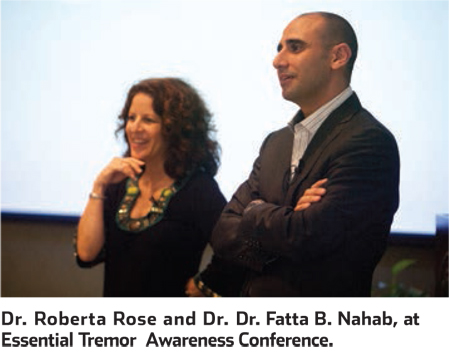 Rocafort was one of 160 people who went to Northern Trust Bank on Thursday to hear doctors detail symptoms,
Rocafort was one of 160 people who went to Northern Trust Bank on Thursday to hear doctors detail symptoms,
causes, treatments and research associated with essential tremor, a progressive neurological disorder characterized by uncontrollable shaking of the hands and arms and sometimes other parts of the body including the legs, trunk, head, voice and chin. Some 10 million people in the United States have essential tremor. There is no known cause. Symptoms range from mild to severe and the condition affects mostly older people with symptoms worsening as they age. However, children can also experience essential tremor.
Joan Marie Barringer, a professional counselor, was only five years old when she started to tremor. She would have occasional episodes, especially during gym class when she was tasked to walk on the balance beam. “I was terrified. My whole body would start to shake.” She didn’t know what she had and was unable to supply an educated answer to family members, classmates and others who queried, “Why are you so nervous? Why do you shake so much?” “I felt frustrated and very alone,” said Barringer, who was eventually diagnosed at age 32 and later realized that she wasn’t the lone sufferer of essential tremor.
“It is a big secret for a lot of people,” she told the group, many of whom closely identified with her personal account of “feeling embarrassed and alone.” She encouraged people to attend support groups, to try a holistic mind, body, spirit approach to treatment in addition to a medical one, and to evaluate their diet and exercise.
Dr. Roberta Rose, a neurologist who practices in Vero and Sebastian, also spoke to the audience, offering an overview of essential tremor. While the condition can be debilitating it does not shorten a person’s life span, she said. It also doesn’t mean someone will develop Parkinson’s disease if they have essential tremor, however some research suggests that essential tremor can also occur with other brain and nervous system problems such as dystonia, parkinsonism and certain nerve conditions passed down through families.
There has been no medicine developed specifically to treat essential tremor, she said, however Propranolol, a beta blocker, and Primidone, a drug used to treat seizures, have been widely used and proven effective in some cases. Both drugs can have side effects.
In studies, alcohol and Botox have also shown to be effective in reducing certain tremors in patients. There is no single test to diagnose essential tremor, but a person with frequent tremors should have a thorough physical exam, have blood work done and a family medical history taken.
Rose implored those diagnosed with essential tremor to take things in stride. “If you take the right attitude, anything you are confronting will be easier, and that is as important as any medicine.”
She also discussed deep brain stimulation, a surgery for those with severe tremors that’s done to inactivate the thalamus, a structure deep in the brain that coordinates and controls muscle activity, without purposefully destroying the brain. Experts think that the abnormal brain activity that causes tremor is processed through the thalamus.
With brain stimulation, electrodes are placed in the thalamus during surgery. The electrodes are connected by wires to a type of pacemaker device called an impulse generator that is implanted under the skin of the chest below the collarbone. Once activated, the device sends continuous painless electrical pulses to the thalamus, blocking the impulses that cause tremors.
Patients can externally turn the generator on or off with a special magnet provided to them. Stimulators may last for several years, and the generator replacement procedure is fairly simple.
The stimulation provides moderate relief to about 90 percent of patients with essential tremor, studies show. Still, brain stimulation should only be considered in cases in which tremors significantly impair one’s lifestyle. Rose cautioned that surgery has risks, and the procedure is not for everyone.
However anxiety-stricken Jerry Peterson, 71, of Sebastian, was about having deep brain stimulation in 2009, his tremors had gotten so bad – he had lost his job in retail, and his fine painting skills were greatly diminished – he felt it was time to face his fears in the hopes of a favorable outcome.
And favorable, he got. “It was worth it,” he said after detailing his surgery with others. “It’s changed my whole life.”
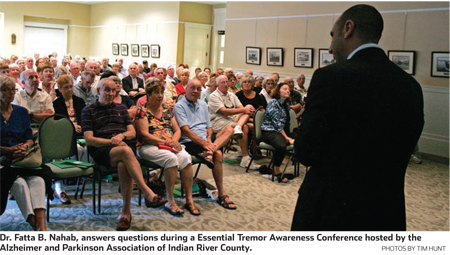 Dr. Fatta Nahab, a neurologist in Miami, wound up the conference with details on recent studies on essential tremor, and a status report. The bottom line: Whilst aggressive measures are being taken by researchers to pinpoint causes and origins of essential tremor, it remains largely a mystery.
Dr. Fatta Nahab, a neurologist in Miami, wound up the conference with details on recent studies on essential tremor, and a status report. The bottom line: Whilst aggressive measures are being taken by researchers to pinpoint causes and origins of essential tremor, it remains largely a mystery.
“Essential tremor is at a very critical time,” he said. “It’s a very difficult time for the field.”
No gene has been identified as associated with essential tremor. There is no known cause. No one knows how to customize treatment for what kind of tremor a person has. There are no medicines developed specifically for essential tremor. There is limited understanding of the causes, brain regions, medications and how the med[icine…]
“There are a lot of unanswered questions,” he said, urging people who are able to, to participate in case studies. “We need your help …… research moves forward, science advances because you all get involved.”
For Rocafort, brain stimulation was a step in the right direction. He has no regrets about his decision to have surgery, so much so that he is considering having another one done to improve his left hand’s functionality.“I feel like a new man,” he said buoyantly of the first go-around. “It’s a wonderful feeling.”
